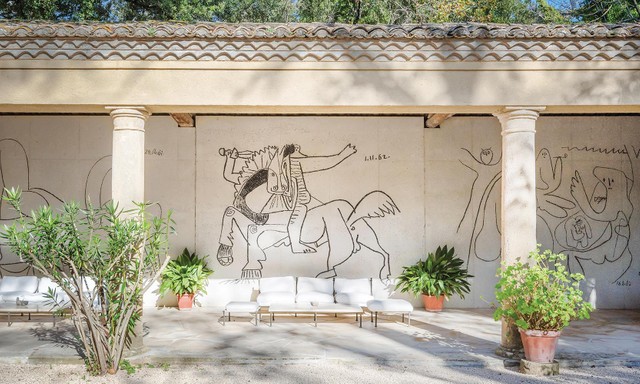
THE ART FORM IS BOUND ONLY BY YOUR IMAGINATION
Few art forms have the same awe-inspired quality as a mural. The sweeping size, the use of architecture as a canvas, the painstaking process—it’s an epic kind of craft.
Murals date back to 30,000 B.C., when they were first discovered painted in caves in southern France during the Paleolithic period. And some of history’s most important works were murals: Leonardo da Vinci’s The Last Supper, Michelangelo’s Sistine Chapel ceiling, Diego Rivera’s Detroit Industry. While these masterpieces were created on the walls and ceilings of public spaces, having a mural in the intimacy of a home is an entirely different experience.
Uzès Sotheby’s International Realty has a rare example of a masterwork mural in a French chateau currently on the market. Located in Provence in southern France, the centuries-old home was once owned by prominent art collector Douglas Cooper, who was friends with Pablo Picasso. “During one of Picasso’s visits to the castle in 1962, Cooper expressed his admiration for the Picasso frescoes he had seen on the façade of the College of Architects in Barcelona,” says Bruno Zermati of Montpellier Sotheby’s International Realty. “To which Picasso replied, ‘give me a wall and I will do the same.’” What resulted were five frescoes Picasso drew on the walls of the home’s loggia.
THE POWER OF TRANSFORMATION
“Murals are only limited by the bounds of your imagination. They can create an architectural vista, a vibrant pop of color, or evoke incredible emotion,” says Benoist F. Drut, owner of Maison Gerard Gallery in New York.
When hand-painted, a mural can create an immersive experience of art, says Lucy Harris, principal of Lucy Harris Studio, an interior design studio in New York. “It’s like a beautiful fragrance or a piece of music—it envelops your senses. Unlike wallpaper, with a mural you can see the brushstrokes of the artist, which adds to the magic.”
And they can also create varying effects. “Depending on the artwork chosen, a mural can convey comfort or have a dramatic and immersive impact,” says Ohio-based Amanda Both, lead designer at Tempaper, a line of removable wallpaper.
MODERN METHODS
Today, the definition of a mural has broadened. “Some sticklers might say it has to be exclusively applied to a wall, but I would also include items like trompe l’oeil painted doors, photography collages, hand-painted scenic wallpapers, and graffiti art,” Drut says. He has worked with New York-based graffiti street artist Faust on a number of commissions to “create great juxtapositions between his witty and bold work and traditional antique furniture from the 19th and early 20th century.”
PERFECT PLACEMENT
“By their nature, most murals are permanent or semi permanent, so moving a piece, whether around the room or the world, can be a challenge,” Drut says. He recommends having works mounted on or backed with muslin to ensure that you can always take it with you.
“I generally prefer murals to wrap around a room, so I consider them to be an effective way to create an immersive experience for my clients,” says Courtney McLeod, principal/founder of Manhattan-based Right Meets Left Interior Design. In a smaller space, a mural on all four walls works best to create an immersive environment. For larger spaces (especially with a long, uninterrupted span of wall space), one mural wall can be an excellent starting point for the overall décor scheme, particularly when it comes to color palette, according to McLeod. “We also highly recommend layering art over a mural scene; the right pairing can create an incredible focal point in a room,” she says.
CUSTOM CRAFTSMANSHIP
A mural should complement the overall décor, so it’s important to also consider the furnishings that fill the space, according to McLeod. For murals that are more lush and more detailed, she recommends using solid fabric on the largest upholstered piece and reserving patterns for accent chairs, pillows, and rugs.
Consider the mood or tone you want to set in the space, Both says. “Murals have the power to influence emotion. Ideas for calming designs include nature or natural motifs and ideas for uplifting and/or dynamic murals include geometric, floral, or botanical motifs.” Other popular subjects include garden scenes, chinoiserie-inspired designs, abstract art, and historical scenes.
If you’re going the custom route, be sure to choose an artist who will be collaborative and open to your ideas but also confident in their own vision, Harris says. “See some of their work in person to make sure you like their style and technique. I always start with initial ideas, usually from historic patterns, and then have the artist take it to the next level with their own ideas.”
CAREFUL CONSIDERATION
Murals are wall art, so you should treat them the way you would treat both art and walls. Keep in mind there is every chance that people (or pets) may brush up against them, or children may put their hands all over the walls, so it’s important to consider durability.
In spaces that get more traffic and/or wear and tear, a vinyl wallpaper can be a great option. McLeod recommends reserving more delicate and hand-painted murals for bedrooms and formal entertaining spaces. If you have your heart set on a delicate material in a higher traffic area, some muralists offer the option of applying a clear acrylic coating, McLeod says.
A busier, smaller pattern shows less damage, and a hand-painted mural can usually be touched up, Harris says.
